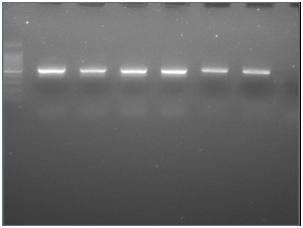Population Structure and Mixing
The aim of this project is to look at population structure of Striped Bass, and the mixing of Striped Bass from Canada and USA origins within the Minas Basin.
This work combines field work, Citizen Science volunteers, and molecular analysis. We are using two different genetic methods. We extract DNA from scale and tissue samples collected by us and provided by recreational anglers. Samples come from Cheseapeake Bay, the Hudson River, and many locations in the Maritimes. Additional scale samples are continually being collected through our Striped Ambassador program. We will compare genetics of Canadian Striped Bass with the USA.
Next Generation DNA Sequencing: The objective is to create a DNA or 'genetic' screening panel for the east coast of North America for all populations of Striped Bass. Dr. Scott Pavey's lab (Canadian Rivers Institute, UNB) is leading this research, but some of the results will form part of Lita O'Halloran's MSc thesis work. We provide samples to Dr. Pavey's lab for sequencing (and also for mtDNA control region work below), with an interest to answer two important questions:
1. Can next generation sequencing tell us more about population structure across the broad range of Striped Bass than previous genetic marker methods? (Lead, Dr. Scott Pavey)
2. What is the mixing rate and timing of Canadian and USA Striped Bass in the Bay of Fundy, and particularly, in the Minas Basin? (Lead, SBRT)
Mitochondrial DNA Control Region: The objective is to see if the control region of Striped Bass mtDNA can be used to differentiate between populations similar to next generation sequencing, but also to see if the control region can tell us anything about the evolution of Striped Bass along the east coast of North America. Elise Hebert (2011 Honours student) and Karen Vaudry (2009 Honours student) completed the first stages of mtDNA control region studies. This work is continuing in Dr. Scott Pavey's lab at UNB in conjunction with next generation sequencing.
Objectives
1. Successfully isolate DNA from fin clips and scales of Striped Bass.
2. Amplify and obtain sequences of the mitochondrial DNA control region and next generation sequences from various populations of Striped Bass.
3. Compare populations within Minas Basin using both mtDNA control region and next generation sequencing.
4. Contribute to a next generation sequencing screening panel for Striped Bass along the entire east coast of North America (Primary work undertaken by Dr. Pavey).
5. Determine mixing rates of Canadian and USA Striped Bass in Minas Basin.
Methods
1. Quickly collect fins clips or scales when a Striped Bass is caught.
2. Isolate DNA from the fin clips or scales.
3. Amplify the mitochondrial control region using Striped Bass specific primers and/or generate next generation sequences.
4. Analyze the resulting sequences.
Results
Some sequences of the mitochondrial control region have been successfully matched with previously existing Striped Bass sequences. One important conclusion is that both fin clips and scales can be successfully analyzed, which means that Striped Ambassadors will be able to augment collections easily. However, variability within the mitochondrial control region was very low, so populations within the Bay of Fundy could not be differentiated using this particular genomic region.

Figure: Gel electrophoresis run on a 1% agarose gel, showing successfully amplified control region bands from Striped Bass fin clip samples.
The Future
More scales are required to complete this work. Anglers can contribute scales through our Striped AmBASSador program. What is required is broad spatial (from different places) and temporal (from different times in the fishing season) sampling (lots of scales from all over) to improve the outcomes using this approach. We hope to analyze Striped Bass samples from multiple locations to compare genetic sequences of different populations and potentially use DNA sequence information to characterize movement patterns.
Project Supervision, Funding, and Outcomes
Elise's supervisors were Dr. Trevor Avery and Dr. Don Stewart; Karen's supervisors were Dr. Mike Dadswell and Dr. Don Stewart. Karen and Elise completed their work at Acadia University with funding was provided by the Natural Sciences and Engineering Research Council of Canada (NSERC) to Elise, and The Canadian Wildlife Federation.